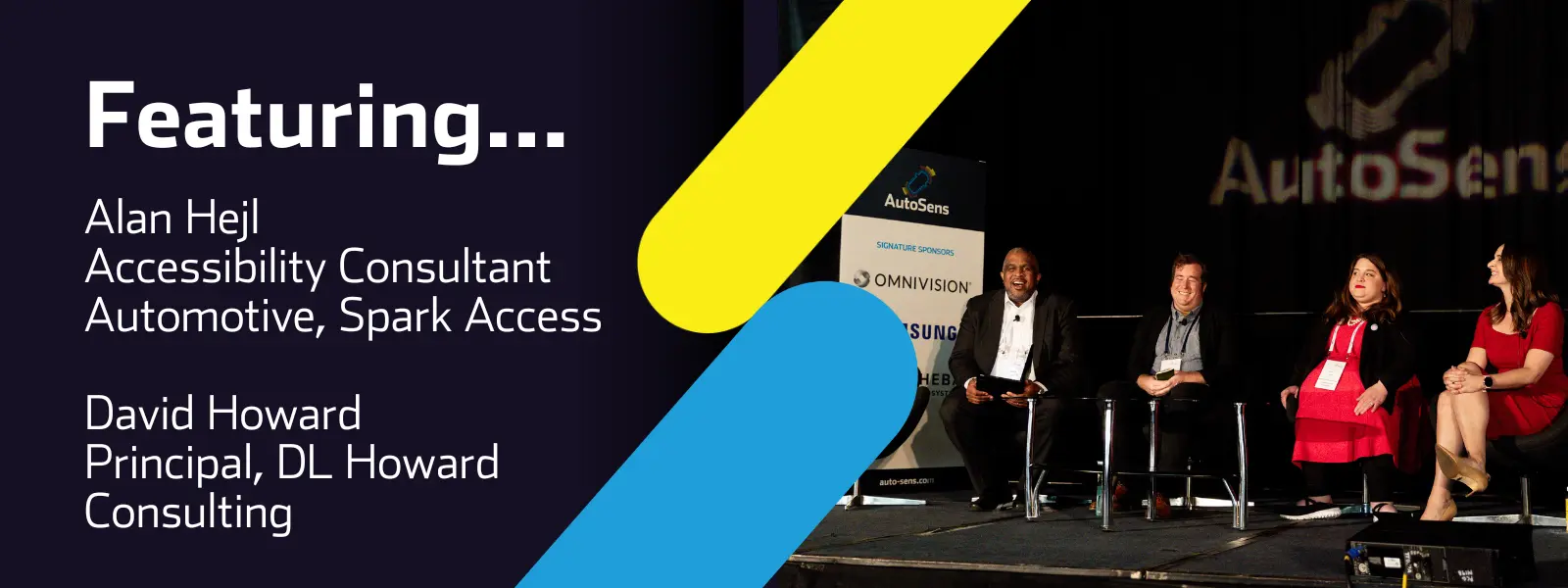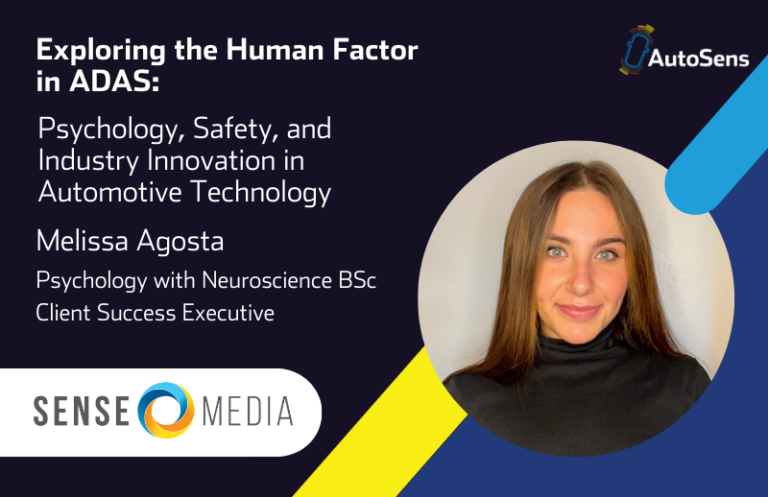Following a groundbreaking panel at AutoSens USA on the importance of autonomous vehicles for accessibility and equity, we caught up with panellists Alan Hejl, Accessibility Consultant – Automotive, Spark Access and David Howard, Principal, DL Howard Consulting to summarise the key points. Alan and David cover use-cases for engineers, V2V and C-V2X technologies and regulatory challenges.

Viewpoints from…
Alan Hejl
Accessibility Consultant – Automotive
Spark Access
1. Your background is in engineering specialising in connectivity for ADAS and AVs. What lead you to pivot to accessibility consultancy for Automotive?
I got into the career of accessibility out of necessity, and my passion to help people help themselves by growing their knowledge. Seeing autonomous vehicle programs and technology decisions being made with assumptions about people with disabilities without seeking firsthand knowledge or growing in-house expertise from PwD is not only an opportunity to do better, but ensure that you’re not leaving customers behind in a responsible manner.
2. Why is it important to improve hiring practices to be inclusive of a more diverse workforce in this field?
In order to build inclusive products, you need an inclusive talent pool and celebrate the different perspectives people bring in the workforce. Autonomous vehicles are a great example – if someone looks on paper and begins a research deep dive on accessible autonomous vehicle requirements, they’ll find a host of data around fixed route transportation requirements that define minimums, but rarely account for a positive and proactive strategy of good customer experience that can solve all the things a barrier-free autonomous vehicle needs to do when no driver or staff is on board for people with disabilities. The only way to succeed in this example is to hire people with disabilities to be in the room with you at every phase, from development to marketing.
3. What sort of use-cases could engineers consider when designing sensing technology for ADAS and Avs?
One of the biggest challenges of new ADAS and AV technologies that are empowering a new way of driving is seeking safety boundaries and building new best practices that strive to be inclusive from the start. One use case that demonstrates this is how information is portrayed – are “go”/”no go” scenarios presented in Red/No Go, Green/Go dynamics? With 1 in 12 men and 1 in 200 women who experience CVD (Color Vision Deficiency/color blindness), red and green can be some of the most dangerous color dynamics for critical self-driving information. Rather than seeking carving limits, embrace the philosophy of the virtuous tornado to make your product more inclusive over time and view adopting new use cases as an opportunity.
To watch the full panel discussion from May, get an AutoSens USA On-Demand Pass.

Viewpoints from…
David Howard
Principal
DL Howard Consulting
1. What key points do you want engineers working in this field to take from these conversations?
Engineers in transportation technology should prioritize accessibility and meaningful impact. Innovations must improve the lives of vulnerable populations and be affordable and widely accessible to benefit everyone.
2. What learnings did you take from AutoSens USA 2024 that you found most valuable?
My key takeaway from AutoSens USA 2024 was the genuine commitment of industry representatives. Walking through the exhibition halls, I was impressed by the depth and dedication of so many companies striving to innovate responsibly. It’s reassuring to see that many of these advancements are aimed at enhancing safety and improving our communities.
3. We discussed the inclusion of people with disabilities, but what other considerations are there for equitable access more broadly in this field? What were your key areas of concern when working for North Carolina USDoT?
Another key aspect of equity in transportation is ensuring that people have access to various modes of transportation, especially those without access to an automobile. At NCDOT, our primary concern was how individuals could travel from point A to point B without a car. To address this, we merged our Bike and Pedestrian Division with our Public Transportation Division, creating the Integrated Mobility Division.
The goal of this new division was to ensure that citizens without automobiles could travel efficiently seamlessly using micromobility options like e-scooters, shared bikes, and/or mass transit to get around the city. One of the more innovative solutions developed through this approach was the on-demand transit service in Wilson, North Carolina. This pilot project became a best practice model, inspiring similar efforts across the country.
4. How could technologies such as C-V2X play into this conversation?
The primary advantage of this technology is its increased accessibility. Key applications will focus on safety, particularly benefiting pedestrians and individuals with accessibility issues. People with cell phones can leverage V2V and C-V2X technologies to enhance various transportation modes, including e-scooters, bikes, pedestrian infrastructure, and public transit.
V2V technology allows vehicles to share information about speed, position, and direction to prevent collisions and improve traffic flow. V2X extends this communication to include interactions with infrastructure, pedestrians, and cyclists, providing real-time data on traffic conditions and hazards.
These technologies can significantly reduce accidents by equipping drivers with detailed information about their surroundings and potential hazards, particularly those involving pedestrians. For individuals with accessibility issues, V2X can provide crucial information about accessible routes, crossing times, and vehicle movements, ensuring safer navigation.
5. What challenges do policymakers face when developing equitable transport policies at the local versus national level?
Policymakers face distinct challenges when developing equitable transport policies at the local and State, versus national levels.
At the national level, the primary challenge is ensuring the consistent distribution of funding and establishing broad policies that address the diverse needs of the entire country. Policymakers must navigate complex legislative processes and balance competing interests from different regions, each with its own unique transportation needs and priorities. This often involves high-level strategic planning and compromise to create policies that can be effectively implemented nationwide.
At the local level, the challenges are more granular and implementation-focused. Local policymakers must tailor national directives to fit specific regional contexts, addressing the immediate and practical needs of their communities. They need to ensure that all residents, particularly those without access to automobiles, have reliable and diverse transportation options. This often requires creative and flexible solutions to integrate various modes of transport, such as micromobility options and mass transit.
For instance, at NCDOT, we faced the challenge of addressing mobility for those without cars by merging our Bike and Pedestrian Division with our Public Transportation Division, forming the Integrated Mobility Division. This allowed us to focus on providing diverse transportation options, such as e-scooters, shared bikes, and on-demand transit services. One notable success was the on-demand transit solution in Wilson, North Carolina, which became a best practice model for other regions.
6. Why are forums like AutoSens and InCabin important for discussing equity and access?
Forums like AutoSens and InCabin are crucial because they bring together transportation technology innovators to discuss, network, and collaborate on important transportation technologies. These conferences showcase innovations while stressing the importance of equity and accessibility in ensuring the safety and well-being of everyone, particularly in accessing education, healthcare, and essential services. It’s commendable that AutoSens and InCabin prioritize both technological advancements and these critical societal needs.







